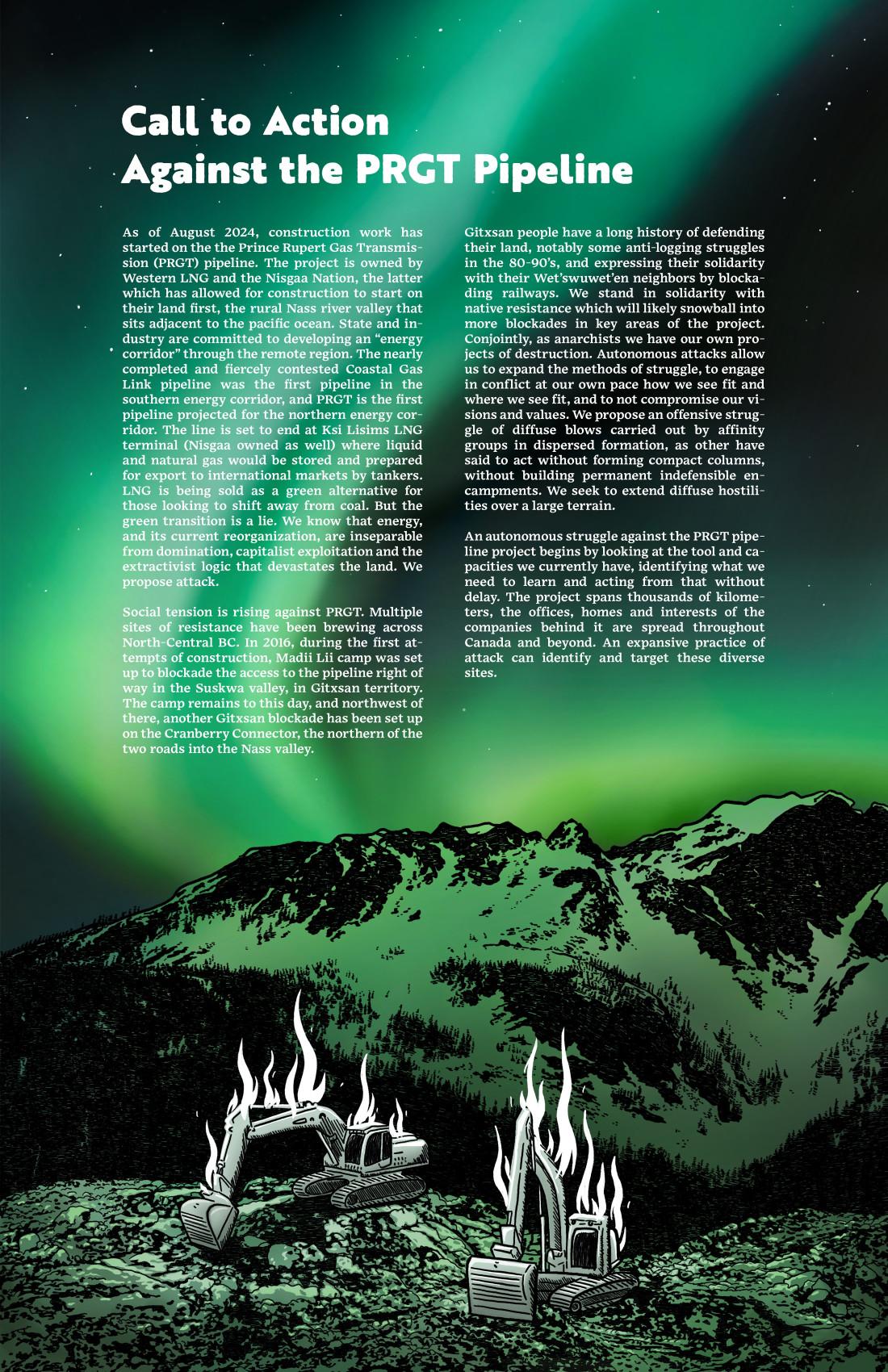
Anonymous submission to MTL Counter-info
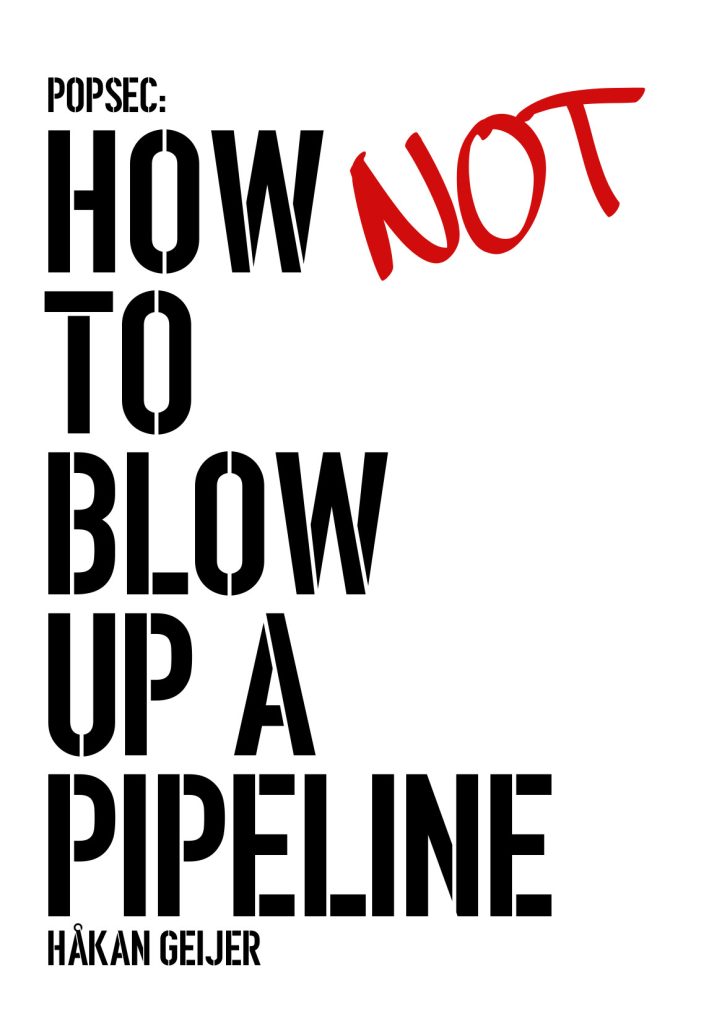
From Riot Medicine
This zine looks at the errors made in the 2022 film How to Blow Up a Pipeline and imagines how the film would have looked if the affinity group took security seriously. Fiction shapes reality, and the analysis is meant to help counter the unsafe practices we see on screen.

Anonymous submission to MTL Counter-info
Yintah is the latest installment of a long tradition of indigenous documentaries speaking truth to power against colonial violence in so-called Canada. The story told is of an anti-pipeline struggle to protect the richness of life that the Wedzin kwa river offers, a decade long fight that involved not only the Wet’suwet’en peoples of northern British-Columbia, but also hundreds of dedicated non-indigenous comrades who fought valiantly alongside them. Except the film chose to cast them aside.
The documentary portrays land reoccupation through the personal projects of Freda Huson and Molly Wickham over the course of ten years, but also makes a point to frame those individual stories in a more expansive and continual relationship of the Wet’suwet’en people to the land. The conflict over industrial and otherwise settler-colonial exploitation of the land is part of the present, past, and future of the territory, and the film does a good job situating the latest struggle against Coastal Gaslink on a longer timeline. The film ends with a strong position of indigenous resilience in the face of lost battles, and should inspire many that the fight is never over as long as we are alive.
A central argument Yintah makes is one most indigenous social movements have been pushing forward in North America, which is that the land should be under local and traditional jurisdiction of its original peoples. This framework opens the door to a legalistic approach to anticolonial discourse (« Who is the rightful decider? »), which Yintah gives legitimacy to for example by recounting the Delgamuukw case as a historical win for the Wet’suwet’en and Gitxan nations. Referring to or using the western legal system is neither revolutionary nor anarchist, and comrades involved in indigenous solidarity work have highlighted this point of tension before. Yintah‘s non-critical approach to legalistic tactics distances its narrative from an uncompromising and feral position against the colonial state. But I guess it also paints a truthful depiction of how unfortunately many activists end up wasting their time and energy in lawsuits and legal cases. If we can briefly hear Freda say Delgamuukw hasn’t changed anything, then why waste precious screening minutes showcasing the legal fight in a positive light beforehand? It only reinforces reformist aspirations to pursue court battles. Relying on the judicial system to recognize indigenous governance also contributes to creating a new class of indigenous elite deciders (sellouts) that move on to exploit the land at the expense of ecosystems. This is happening right now as the Nisga’a Nation, an indigenous political entity legitimized by a treaty signed in 1998, has welcomed and invested in the construction of the PRGT pipeline, northwest of the CGL line.
The question of jurisdiction is not where anarchists and indigenous land defenders share the most affinity. Indigenous jurisdiction, even put through the lens of a pre-colonial political system, opens the door to legitimizing forms of authority that, in a decolonized future, would pit anarchists against indigenous figures of power, and is also today encouraging power imbalance on current shared sites of struggle. Thankfully Yintah does not shy away from including one scene that recounts one of the most discordant moments of the struggle when chief Namoks decided on his own, in fear of police use of force, to open the Unist’ot’en gates to pipeline workers, against the will of companions on site and Freda herself. This was not the only moment when power was yielded in the name of Wets’uwet’en traditional governance and at the expense of the fight against police and CGL. But it was maybe the most impactful one, and I am thankful this movie scene offers a brief moment of nuance in an otherwise sugarcoated version of the power dynamics on the frontline.
Land is of course absolutely central to anti-colonialism. During the struggle against the Northern Gateway project, the Coastal Gaslink construction and the RCMP’s heightened presence (roughly the 2012-2022 decade), the backroads territory has been the site of an impressive game of snakes and ladders to control the access to isolated valleys. Yintah chose to dedicate a lot of its screening time to traditional uses of the land. We are shown many scenes of harvesting game and berries, the importance of transferring wet’suwet’en knowledges and values to younger generations and the relationship between traditional ways of life and health. Crucial to the #LandBack movement and Indigenous resurgence, I understand why these themes are explored as an exclusively wet’suwet’en story. But the story of confrontation with pipeline projects was not exclusively wet’suwet’en, and Yintah turned a blind eye to the central role anarchists playedin defending the land against industrial invasion. This is what every comrade has been whispering about since the film came out. Over the decade, there has been hundreds of anarchists who, from far away and traveling onsite, dedicated their hearts and their time and sometimes took immense risk to defend wet’suwet’en land. Anarchists organized solidarity actions in both affinity based models and in larger scale social contexts across the country, expanding all the way to Europe and the Pacific Northwest of the US for years, and insurgent tactics have flourished during #ShutDownCanada. According to many first hand accounts, the frontline camps could not have survived without anarchists’ contributions. The struggle was huge and has changed many non-wet’suwet’en people’s lives, many anarchists, and many others as well. Including the solidarity from non-Indigenous peoples would only have strengthened the Wet’suwet’en story of resistance, not diluted it. Do we have the audacity to bring this up as a grievance to our Indigenous friends? Is it totally misplaced to critique an indigenous film that makes no place for non-indigenous peoples? Not PC for sure.
The narrative choice of Yintah to focus on Molly and Freda also sometimes feels almost claustrophobic, and we lose a sense of the scale of the movement that involved thousands. There is a risk that countless people will watch Yintah and think that such a large scale moment of rupture rests on the shoulders of a few key figures, or that indigenous resistance can make do without the solidarity of allies and accomplices across all social identities. Leadership is a natural human dynamic that can organically move people to act, and can shift depending on the relationships in a said group. But there is a fine line between recognizing leadership qualities as natural and beneficial, and the development of a cult of personality that can be created by certain media deformations. The image of Gidimt’en Checkpoint portrayed through its media channels (instagram and youtube) has misled many folks who have unfortunately showed up to camp with unrealistic expectations such as finding a space that is constantly active in preparing confrontation or occupied and maintained mainly by Indigenous peoples. The mediatic focus of the struggle might also have put too much weight on our heroines, and health and the need for a sustainable involvement has been deprioritized. One of my concerns for upcoming struggles is that the film could embolden identity politicians to recreate a social hierarchy that enables abuse of power on future frontlines.
What I find unfortunate is that there is the propensity in activist discourse to constantly portray oneself as a victim. Yintah is unfortunately no exception. The 1h45 minutes of the documentary painfully recounts all the possible events and situations under which the state, the police or extractive industries have oppressed the Wet’suwet’en peoples. Not that we must shy away from truth speaking, or that the string of events of the struggle should be manipulated or distorted (blockades were dismantled, cabins destroyed, people arrested, and so on), but every publication whether it be book, artwork or film, makes choices in the words used, the scenes that are shown and the potential scenes that are left out. The History we remember is the one some chose to write how they saw fit. There are ways to speak of and against domination that are unapologetically defiant, with our sight set on the target. CGL might have completed its construction, but it took them extra billions and a couple years more than anticipated, because a handful of strong hearts were barricading roads, scaring away pipeline workers and sabotaging their equipment. There were countless confrontational moments on the territory that were (maybe, maybe not filmed) left out of the editing. With its narrative constructed around resilience instead of resistance, Yintah might not be able to inspire others to draw their daggers.
It might not be our Wet’suwet’en companions’ responsibility to tell our side of the story, but our complete invisibilisation from the struggle is basically dishonest. If we take a step back, we can see this situation is not new in the historiography of anarchism. Unpleasant to the general opinion and defiant to the leftist movements, anarchist action and involvement in historical events has always been undermined, evacuated, or falsified when it was time to write down a page of History. In some ways the film continues the legacy of writing off anarchists as outside agitators. Instead of recounting how anarchists have been invited to come to the frontlines and have engaged with land defense in a sustained way for years, Yintah litteraly places anarchists outside of the frame of legitimate participants in the struggle, and leaves room for the liberal media narrative of violent hijackers to step forward. This is hard to digest, when we know in reality that there were moments when only masked white anarchists were present and they were asked to pose with warrior flags for a good photo op. As I write this, land defense in northern BC has already kicked off a new chapter of resistance, this time against the PRGT pipeline. When non-Indigenous anarchists show up, they might be once again be met with confusion from Indigenous peoples, just as they were at times during the wet’suwet’en struggle, faced with questions like “why are you here ?” rather than being understood as part of a larger fabric of anti-industiral actors in the region.
Yintah has only received positive public feedback. What is the point of yet another text doing the devil’s work at pointing at the problems? While I wanted to share what I think is valuable criticism that was discussed amongst friends and companions around me, I still think Yintah tells a beautiful story of two exceptional women that is worth sharing, and a story that hopefully inspires other Indigenous peoples to reoccupy their land and defend it against industrial destruction. What I take away from watching the film is the motivation to support and contribute to anarchists telling their own histories. In a world of overlapping truths, different layers of experiences and their takeaways can compliment and contradict each other. We do not need one official History of the past decade of struggle on the yintah.
“If anarchists don’t make their own History, their enemies will. […] Should we not wish that our stories end up in the hands of those who could only write them to suit their own needs” (Plain Words, Roofdruk/Compass editions, 2024).
In an anarchist history of the struggle on the yintah, the question of jurisdiction and other legal approaches would be presented as hindrances to the liberation of land and life. In an anarchist history of the struggle on the yintah, internal conflict would not be shoved under the rug but taken as an opportunity to try to draw lessons from, so we can continue to deconstruct how we relate to each other outside of civilization’s dogmas. In an anarchist history of the struggle on the yintah, we would recount the dozens of barricades on fire, cop attacks and destroyed machinery to remind us we are truly alive and free in the blissful moment of action. And there would probably be many more anarchist histories of the struggle on the yintah, I am after all just one amongst many anarchists.
Suggested further reading
Between Storms, anarchist reflections of solidarity with Wet’suwet’en resistance
Water Falling on Granite
The visceral viewpoint
Call to action against PRGT pipeline
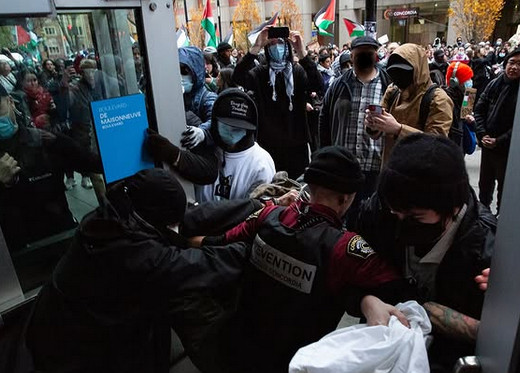
Anonymous submission to MTL Counter-info
Strategic takeaways TLDR:
1) It does not take many people to change the course of a protest.
2) When the police are busy defending a fixed point it opens possibilities for exciting action in other places.
3) Our comrades can be de-arrested, and doing this against security officers is good, lower-stakes practice for doing it against the police
The takeover of Concordia’s Hall building was yet another instance of the slow building militancy in the Tiohtià:ke (Montréal) solidarity movement for Palestine.
On November 21st, over 85,000 students across Quebec were on strike demanding their academic institutions align with the Boycott, Divestment, and Sanctions movement, drop the political suspensions of student activists, and against police on campus — making it possibly one of the biggest strikes for Palestine, outside of the occupied territories, in world history.
Committed to swinging the protest into a more combative stance, the rough idea was to make the Concordia rally on the first day of the province-wide student strike for Palestine militant enough to force the university to shut down for the day, thereby enforcing the strike mandate and causing maximum disruption. The primary proposal for doing so was to take over a building.
On the day of the rally organized and publicized by Students for Palestine’s Honour and Resistance (SPHR) Concordia, a few anarchists from all over the city (collaborating across Francophone and Anglophone milieus) found each other and shared ideas for ways to make the rally more interesting and disruptive. To avoid another ritualistic demonstration of the same chants and speeches, they decided they would try to enter Concordia’s Hall Building: the center of the University’s student activity, and known target to the broader Tiohtià:ke anarchist community that was hit several times in the fall 2024 semester, causing hundreds of thousands of dollars’ worth of damage.
The building was being guarded by a line of private security mercenaries — not exaggeration, everyone would soon find out that these goons were hired by the university from “Perceptage,” a security firm whose CEO advertises his IDF training. After some comrades grabbed hold of the door and held them open, a first group of brave protestors pushed through the security line yelling “move” and beckoning for the crowd outside to join them in storming the Hall lobby. The crowd reacted quickly and did just that. Security also reacted quickly and violenty grabbed the first few comrades pushing through, putting them in head locks and ripping their clothes, but other protesters fought back, grabbing onto their comrades’ bodies and tearing them out of security’s grasp. These were the first sucessful de-arrests since Concordia security began their practice of “citizen’s arrests” at protests, and it showed that our comrades can be snatched back if we move fast. Doing so aginast unarmed security can be good, lower-stakes practice for doing so against the police
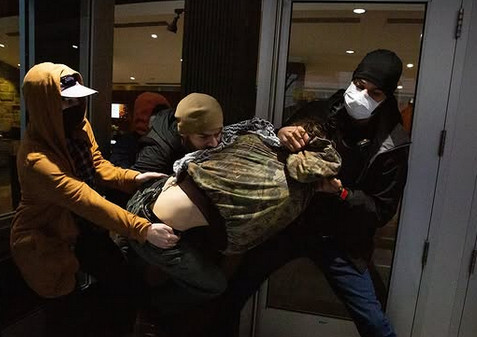
Security soon realized they were totally overpowered and outnumbered and stepped aside, defeated. They could only watch as hundreds of students and “outside agitators” stormed the Hall building lobby.
Meanwhile, the riot police – who are often a significant factor at protests in Tiohtia:ke due to being highly equipped (tear gas, pepper spray, etc.) and trained more specifically for “crowd control” than riot cops in other cities, were busy forming a barrier around a small group of zionist counter-protestors. As was seen a number of times over the summer, when the SPVM have a fixed point they must defend, it can open up possibilties for protesters.
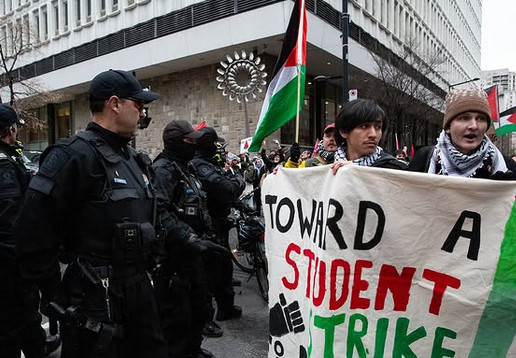
Having flooded the Hall building lobby, pacifying speeches on a megaphone began once again, and anarchists were seen continuously beckoning the crowd to remain dynamic and to begin going upstairs by chanting “Who’s school? Our school!” Some protesters spoke to the people giving speeches, who then announced to the crowd that people were moving upstairs. A critical mass began to move and a snake-demo through every floor of the Hall building ensued. Protesters were seen spray painting, disabling security cameras, tossing garbage cans onto the floor, creating chair barricades outside classrooms, even expropriating expensive university equipment, all as security just sat back and watched helplessly.
The dynamic movement created a real feeling of empowerment, and hopefully will encourage more serious attempts to liberate space and resources from the university. What felt powerful to see on this day was that it only took a handful of protesters to secure the doors, and with 15-20 militants on hand the protest shifted from a standard rally on the street, to a disruptive snake demo through a 12 story building. This taking of the school by force was something the secuirty was clearly desperate to avoid, and they responded by sending out an emergency alert encouraging people to avoid the area, as well as a message to professors that resulted in some classes and exams being cancelled into the evening. The day’s success was made possible partly due to activists at Concordia continuously organizing and trying to increase militancy and build relationships; there had been many previous unsuccessful attempts to escalate.

Surely thanks to a large portion of the crowd being in full kuffiyeh, black or student bloc, and totally concealed, as of this day, no one has faced legal or academic consequences for Thursday, November 21st actions.
There were also reports that an hour earlier, at McGill university, fire alarms were simultaneously triggered in every building on campus, forcing students out into the lawn where they could join the walkout happening at the same time.
The strikes served their function very well in this case, freeing up student time and energy and creating the conditions for an action that otherwise hasn’t been pulled off.
The 21st was unequivocally a success, yet there were a few things which could have made it even better and more impactful:
Despite there being room for improvement, we can still celebrate and try to reproduce the palbable feeling of liberation, freedom and empowerment that filled the hallways of the university that day.
Further Reading and Resources:
No Security in Repression: Policing Collective Action for Justice at Concordia and Beyond
Follow ClashMTL on Social Media
It All Goes Or it All Stays the Same
Mask up, You’re on Camera (physical copies distributed around Concordia)
The University, Too, Must Be Destroyed
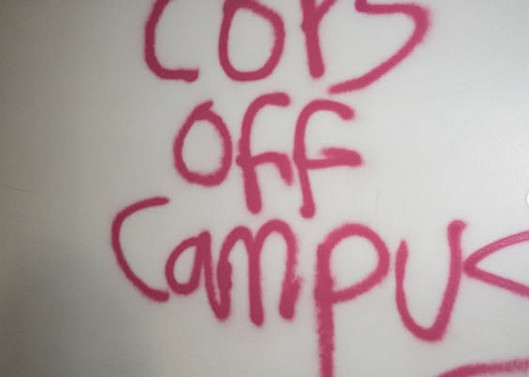
Photo credits to William Wilson (@williamwilsonphotography)

From Ni Québec Ni Canada
Text and Campaign by Shanipiap
Greetings!
We wish to share our story, we, the guardians of the land. We are Innu, allies of nature, the first inhabitants of the forests of North America. Today, we are the Indigenous communities who have always occupied the territories of Kupek (Quebec), as our mothers called it.
Our ancestors have passed down the responsibility, generation after generation, to uphold the belief that Mother Earth is a living spirit who takes care of all humanity. Throughout time, we have been people who know how to share among ourselves. We are not perfect, but we are curious beings.
Nearly 500 years ago, our ancestor woke up next to a new neighbor and wondered, “Who is he?” This marked the beginning of an unspoken welcome in our land. From treaty to treaty, we were pushed further and further into the forest, trying to survive in the face of waves of new arrivals. Until the 1970s, northern Quebec was still well-protected for our hunters by governments. But since the signing of the James Bay Agreement, the province of Quebec has been exploited by forestry, mining, and oil companies all the way to the Far North.
Because we are who we are—bound to our natural values as protectors of the land—we want to continue safeguarding what little remains. Currently, we are on Territory 59 in Dolbeau/Mistassini in Saguenay. We have lit a sacred fire as a symbol of hope. We want our voices to be heard for the survival of this forest.
Learn about the Petapan Treaty; there is information available online.
As for us, it is certain that we will continue this ancestral struggle. “It is our vital duty,” as the firekeeper says in the film.
We need help to continue working faithfully as guardians of life on this territory. Right now, the urgency of defending this forest, its water, its animals, its vegetation, and the well-being of future generations is alarming. So, if you wish to help us, you can support us with donations so this struggle is not in vain.
We thank you! Tshinashkumitinan!
To donate to the fundraising campaign : https://www.gofundme.com/f/8xm5mx-toi-tassetoe-cest-mon-droit-de-vivre-sur-ma-terre

From PRISM
December 10, 2024
by William C. Anderson
The UnitedHealthcare CEO’s assassination is a good time to observe the history of class warfare, grievance, and the classic anarchist militancy of “the propaganda of the deed”
“Who is it that provokes the violence? Who is it that makes it necessary and inescapable? The entire established social order is founded upon brute force harnessed for the purposes of a tiny minority that exploits and oppresses the vast majority.” – Errico Malatesta
“Once a person is a believer in violence, it is with him only a question of the most effective way of applying it, which can be determined only by a knowledge of conditions and means at his disposal.” – Voltairine de Cleyre
The killing of UnitedHealthcare CEO Brian Thompson on the morning of Dec. 4 may have shocked people for several reasons. A masked gunman committing a targeted killing with tactical precision before making an illusive escape stunned authorities and captured the imaginations of others, offering him instant celebrity status. Gunning down an insurance executive became a cathartic scene with all the trappings of cause célèbre. The initial reaction should be analyzed to understand what it communicates to us. This sort of violence holds a special place in the history of insurrectionary anarchism, which has not only theorized about it but actively practiced it to world-changing ends. A killing is not just a killing, and the popular reaction to the shooter can supply us with some important lessons just as police close in on a suspect. If the authorities are not careful with this case, they may end up uniting people behind common interests. Now is a good time to observe the history of class warfare, grievance, and the classic anarchist militancy of a form of direct action meant to catalyze revolution, known as “the propaganda of the deed.”
In 1885, the Chicago Tribune quoted the formerly enslaved Black anarchist Lucy Parsons saying something many wouldn’t dare say almost 150 years later: “Let every dirty, lousy tramp arm himself with a revolver or knife and lay in wait on the steps of the palaces of the rich and stab or shoot the owners as they come out. Let us kill them without mercy, and let it be a war of extermination and without pity.” Far beyond a mere call for sporadic violence, it’s essential to understand that the impulse to make such a confrontational statement was not so unconventional back then. Different factions of anarchists used calls for revolutionary violence toward different ends and influenced one another.
While some, like Parsons, worked with organizations like the International Working People’s Association (IWPA), doing pivotal work to transform labor conditions, others had individual motives based on self-organized immediate interventions. The historian Paul Avrich noted that the violent rhetoric of anarchists like Parsons attracted the “skilled and unskilled, employed and unemployed” based on the “hopes of immediate redemption.” However, some people took that mandate into their own hands, targeting some of the world’s most powerful elites.
Anarchists went after and often successfully assassinated multiple heads of state, politicians, businessmen, military figures, and police around the world under the proclamation of propaganda by the deed. The idea that killing reviled and oppressive authority figures would be a catalyst for revolution has long been debated. These ideas are not limited to just one faction of anarchists or only the anarchist segments of the historical socialist and communist movements. Furthermore, their effectiveness often produced unintended consequences that the purveyors couldn’t have necessarily predicted. For example, when a self-professed anarchist killed President William McKinley in 1901, it led to the creation of the FBI and a proto-“war on terror” that reshaped international policing and worldwide immigration policy and nearly destroyed anarchism. Understanding this in the context of Thompson’s killing in New York should let us know that the ruling class won’t simply accept this. The protectors of their interests and property, the police, will do their bidding to make an example of the killer (or a necessary scapegoat). Authorities will also be hard at work deciding what agencies, legislation, or punishment should be meted out to stop lethal direct action from becoming too popular. Just as it has been throughout anarchist history, quashing such jubilance and excitement about the collective awakening to the possibilities of violent resistance will be necessary.
Anarchist proponents of violence like Errico Malatesta, Johann Most, and Luigi Galleani saw attacks as a necessary response to the oppression of the working class, immigrants, poor people, and the enslaved. Even Alexander Berkman, who wrote about the anarchist movement’s departure from the propaganda of the deed, attempted to assassinate the industrialist oligarch Henry Clay Frick who turned guns on workers and was tyrannical in his business practices. Berkman once wrote, “You don’t question the right of the government to kill, to confiscate and imprison. If a private person should be guilty of the things the government is doing all the time, you’d brand him a murderer, thief and scoundrel. But as long as the violence committed is ‘lawful,’ you approve of it and submit to it. So it is not really violence that you object to, but to people using violence ‘unlawfully.'”
Berkman’s nearly 100-year-old perspective still holds, though what’s interesting now is seeing a murder bring people together. Anarchist history shows that sometimes it’s unexpectedly hard to find a prominent figure so universally reviled that nearly everyone celebrates their ending. Though many have prefaced their commentary on the current moment with the need to say they don’t “condone” violence, Berkman’s point bites back at inconsistency. The monopoly on violence known as “the state” conducts regular killing both directly and indirectly the world over daily to maintain itself. Also, do those who don’t condone the killing of a businessman by a vigilante announce they don’t “condone” violence before using their conflict mineral technologies with apps that use artificial intelligence powered by slave labor? Do they announce that they don’t condone violence when they pay taxes to fund a genocidal onslaught or militarism that destroys the planet? What about the violence on our plates in our food or in the “fast fashion” we wear? No, that inescapable violence is accepted as ordinary and not worth showy moralizing statements.
Those who denounce killing in response to the shooting of Thompson reinforce the imbalance that upholds oppression. Blood has different weights depending on where it spills from. Who has the power to kill as an acceptable norm versus who doesn’t is what tips the scale. The gravity given to those this society privileges, empowers, and prioritizes dictates how much we’re supposed to care about deaths. It also dictates what’s even considered violent. That’s why we are instructed to mindlessly condemn any and every act of violence that threatens the status quo of capitalism, imperialism, and class-based society. We should be able to respect those who choose not to practice violence while distancing ourselves from those who make false equivalencies out of it. Their “peace” comes at the expense of the most abused, whose screams are drowned out. This is the “peace of the pharaohs, the peace of the tsars, the peace of the Caesars,” as Ricardo Flores Magón once wrote and rightly concluded, “Let such a peace be damned!”
It would be helpful if more of us accepted the fact that we cannot indeed be anti-violence in a society where even our most passive actions are reinforcing the most deplorable crimes against oppressed people around the globe. This is why I’ve argued that we should identify the counterviolence we need in our politics. So, rather than projecting onto a mysterious shooter or endlessly looking for a hero to venerate, the questions of the utility of violence here are answered by past instruction. However, I do not invoke all this history and quotation to suggest it’s inherently instructive for mimicry. Instead, I think it helps us realize that there is something beneath the surface here that people yearn for. There’s a confrontation dying to be taken up by those who refuse to wait for more tragedy and endless pain. Such a clash isn’t expected to be neat, nice, or consistently nonviolent. If force is the tool used to shape our subjugation, then pushing that oppressive momentum back so that we can completely throw it off of us should be the standard.
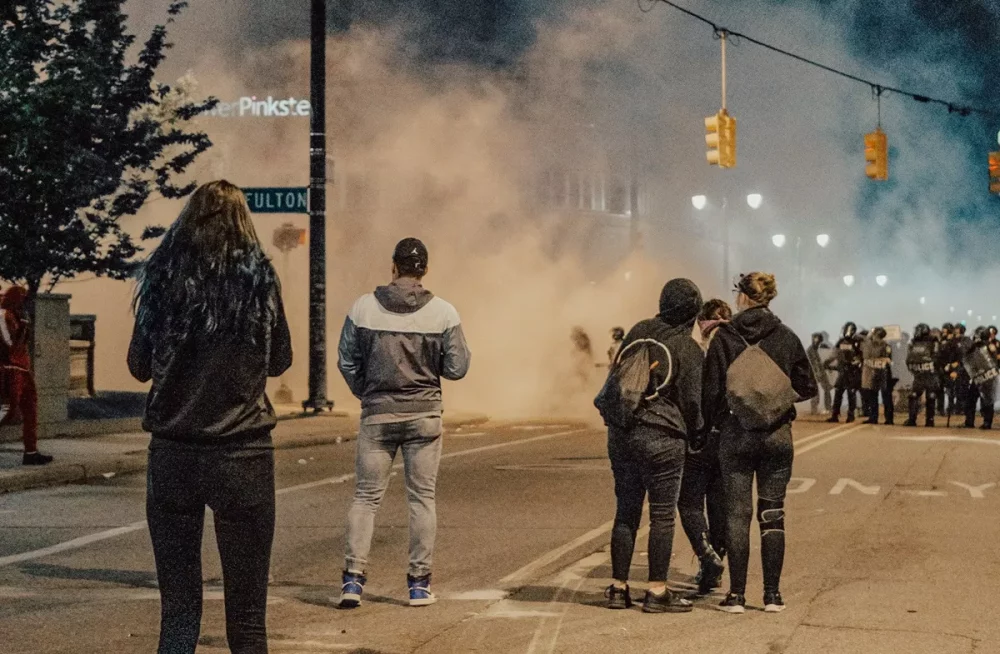
From It’s Going Down
A week ago, It’s Going Down published a statement announcing that we were putting this project on hiatus after ten years. Tired and burned out, we were gambling our absence wouldn’t be missed. In short, the response from readers, friends, and long time collaborators was overwhelming and clear: many feel this project is important and should continue. We appreciate all of the incredibly kind words and those who took the time to reach out to us.
With this encouragement in mind, we have decided to continue publishing at It’s Going Down and operating the platform for the near future. Going forward, we want to focus on quality over quantity and also attempt to cultivate again a culture of report-backs and movement journalism as we go into the second Trump period. We also realize that this isn’t 2017 anymore; the site may be updated less as it has been in the past.
We also want to salute all of the new (and old) anarchist and autonomous media projects that have sprung up in the last few years: hopefully we can continue to be part of a burgeoning grassroots media eco-system where we learn and grow from each other.
A few updates:
Moreover, if you are interested in contributing to the columns In Contempt, which features a roundup of news, action, and updates about political prisoners, repression, and abolition, or This Week in Fascism, which discusses the far-Right and antifascist resistance to it, please reach out to us at: info [at] itsgoingdown [dot] org. Have other ideas? Drop us a line!
Lastly, since folks have asked if they could help donate to support our work, we want to instead encourage people to donate and help sustain mutual aid and autonomous infrastructure in their local areas. If you can, also consider helping these organizations and their work:
Life, finds a way. So will we. See you soon.
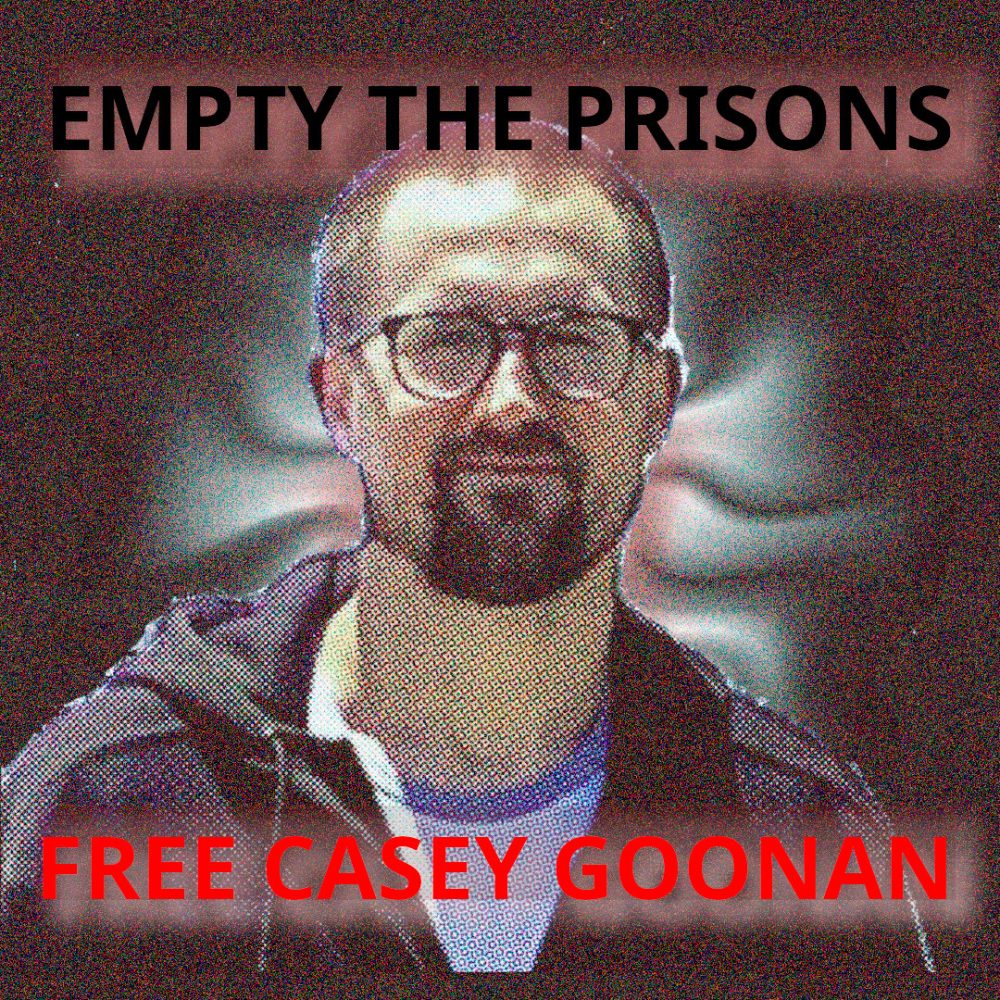
Anonymous submission to MTL Counter-info
Casey Goonan is the only US political prisoner from the 2024 pro-Palestine student encampments. They are an abolitionist and anarchist who has dedicated themselves to multiple forms of prisoner support work and directly engaging with incarcerated comrades. The impact they’ve made inside is prevalent, as indicated by statements from their comrades Stevie Wilson and Hybachi Lemar. They’ve always pushed to ensure an understanding of Black struggle and revolt as central to their abolitionist work, and through understanding the totality of anti-Blackness the importance of an anti-police and anti-prison perspective was brought into any and all of their efforts towards liberation.
In June of 2024, they were arrested by a task force comprised of the FBI and other law enforcement agencies in connection with an alleged direct action which took place in solidarity with the UC Berkeley encampments which had been brutalized by police and zionists earlier in the year* . If convicted, they could face up to 20 years in prison with a minimum sentence of 5. The investigation and court proceedings are currently ongoing but a non cooperative plea deal is pending in which Casey will plea guilty to one charge to allow additional charges to be dropped. This plea deal does not include information or testimony against anyone else.
While Casey has received a great amount of support from decentralized community in New York, Chicago, California, and elsewhere, the pro-Palestine movement needs to be publicly and actively supporting them. Right now, their primary accomplices are those who personally know them, those who prioritize prisoner support, and fellow anarchists. Despite vague assertions of the interconnectedness of repression and struggles between the American policing and prison apparatuses to that of Israel, there has been little material manifestation from that understanding within the US pro-Palestine movement. Meanwhile, coordinated struggle between prisoners and outside militants has been a key point of success for Palestinian liberation.
We must recognize the necessity of attacking the infrastructure of occupation domestically. Amidst calls for escalation, it is of vital importance to defend those experiencing repression from the legal system. To not do so is to allow one of the state’s most well-funded and structured counterinsurgency tactics to take complete hold of movements. If people are abandoned to incarceration, the fear of repression will throw everyone towards inactivity. This need for defense is especially true for those facing charges beyond the more palatable ways of dissent, like marches and encampments.
State repression must be met with expanding our community resources to reach those inside. Bravery must be met with support.
It’s not surprising that, despite the large presence of the Palestinian diaspora in the American pro-Palestine movement, tactics focus primarily on vocalizing dissent through marches and making demands of the state, which are a far cry from the struggle within Palestine itself. This is partially attributed to the class character of the diaspora — a petty bourgeois group would have no investment in attacking infrastructure they partially benefit from even if that same infrastructure perpetuates the genocide of indigenous groups including Black people and Palestinians both domestically and globally. Equally, the motivations and interests of the community organizations and student groups that are largely in control of the movement not only harbor that class character but also rely on funding from the infrastructure they refuse to attack. Despite the student movement being referred to as an intifada, it’s activity is incomparable to what has occurred during the numerous intifadas leading up to the Al-Aqsa Flood.
Considering pro-Palestinian community groups and political organizations like USPCN, CJP/SJP, Dissenters, NAARPR, JVP and PSL are supplied with enough funds to bus people in for marches, plan conferences, and campaign for local policy, certainly donating money towards legal fees for those facing repression would be no issue.
Even with all the attention and credibility being given to the pro-Palestinian student movement and despite the numerous pro-Palestine student groups on university campuses, there have been no publicly circulated student-led support efforts for Casey. Outside of participants of the Columbia University encampment, there has been no mention of them from any other university space, most likely attributed to groups aligning themselves with certain tactics, a hesitancy towards anarchists, and the fear of repression.
Beyond the bare minimum of ensuring people are supported in obtaining adequate legal counsel, any revolutionary horizons with teeth require long term prisoner support. This practice is key to the current struggle that led to the Al-Aqsa Flood as exhibited by the rich history of organizing within prisons and the ongoing liberation of those being held hostage by Israel. In Khalida Jarrar’s words, “[t]he ongoing conquest to liberate prisoners is in tandem with the Palestinians’ constant and multifaceted struggle against colonialism. Hence, the slogan “emptying the prisons” is derived from and a core component in the Palestinian struggle through various stages in its history.”.
Those of us living under a plantation economy already have our own reasons to ensure incarceration is a central site of struggle. But if one does insist upon taking guidance from elsewhere and if one intends to “bring the Intifada home” or “escalate for Gaza”, Palestinians have provided plenty of methods for how carcerality can be attacked.
Casey understood this prior to their incarceration and there’s no doubt this knowledge influenced their own political horizons. If the pro-Palestine movement wants to also tote itself as an intifada they should take note of the militant organizing and support infrastructure within and between prison walls that occurrs in Palestine. Abandonment of prisoners is where revolutionary ideals die.
Empty The Prisons Free Casey Goonan
For More Info and Updates on Casey
cscommittee@proton.me
freecaseynow.noblogs.org
IG: @freecaseynow
Ways to Support Casey
– Organize a fundraiser for legal fees, commissary, or a nutritional package
– Host a letter writing night
– Form a defense committee
– Make + put up some propaganda
Readings Recs
A Practical Guide to Prisoner Support
Practical Abolition From The Inside Out
More Effective Prisoner Support
The Soledad Brothers Defense Committee: A Brief Consideration
San Quentin Six Defense Committee
A Spirit, Unbroken (Discusses the Martin Sostre Defense Committee)

Anonymous submission to MTL Counter-info
This is a raw, underdeveloped reflection on why political assassinations of CEOs, politicians, slumlords, etc., should happen more often. The assassination of UnitedHealthCare Executive CEO, Brian Thompson left me spiralling in a myriad of unexpected ways, mostly around these two questions: why doesn’t this happen more often? And perhaps, why do anarchists seemingly no longer do this?
Assassinations are primarily political. They are a radical act resulting from either a political analysis of power, or a threat to the order of it. Police, state, and corporations commit assassinations but they use their justice systems to legitimate them.
I find myself so hesitant to discuss with some of my most trusted, beloved comrades. It feels so taboo. What has liberal democratic propaganda done to anarchism that makes the topic of assassination so uncomfortable to talk about it as a rationale and reasonable act? Even if we hate to admit it, non-violence has a more pervasive creep than many of us are willing to admit.
In some circles, I hear a lot of people talk about the necessity of violence, but I’m not sure if it’s anything more than a romanticized notion of it. The experience of committing violence against one’s adversary is many things, though it often comes with a rush of adrenaline, sometimes a fleeting sense of euphoria, but it can also come with nausea, shock, and the intuitive feeling that with every act of violence a piece of one’s self is forever changed.
And at the same time, what the fuck world? We’ve been shown that the legal system is a joke. We know laws are made for the most powerful. We know that politicians don’t care about systemic change, but rather, they are more invested in the maintenance of capital and state order albeit with different takes depending on the political party. We know demonstrations alone don’t work, we know breaking windows or setting an executive’s car on fire isn’t enough to deter or intimidate, so what is one left with to do? What is left to be done so that when one says, “no, this will not happen any longer,” and acts accordingly, it happens no longer?
Those who have power and shape the socio-political terrain of this world will not step aside peacefully. We are fucking delusional if we think that another petition, demo, vigil, frontline is going to change anything. While friends and comrades caught RICO charges from the Stop Cop City struggle, Donald Trump caught the same charges and became President, again!
The state uses the police to back multibillion dollar projects. We cannot win when we try to stand against them as equal opponents, even in asymmetrical attacks the outcomes are grim. But if the heads of corporations, etc were killed, one by one, think of the way their networks would implode into chaos because of the fear and knowledge that they are no longer untouchable? They can be found. I’m not saying that assassinations are the only thing left to do. I’m just wondering aloud into the anarchist universe as to why this tactic is used more by the state, the police, etc., and less by individuals who understand/ experience the harm and greed of certain individuals who just need to die.
Millions of people applauded the recent assassination of UHC CEO Thompson, they also applauded the most recent assassination attempt of Trump. We are on a precipice. I want those reading this text to seriously examine their relationship to violence. Ask yourself and trusted friends, “how far are you/ am I willing to go?” Would you know the conditions necessary for that relationship to change or intensify? Or, do you provide endless justifications as to why a tactic of accelerated violence won’t make a difference. Be honest. Sometimes we say such things because we are just afraid of the consequences of getting caught or failing. When we are honest about our fears we can make plans to move beyond them. What things would you need in place to feel like you could increase your capacity to act violently? And to that end, to commit an assassination?
Assassinations are an anarchist tactic. The following is a list of known anarchist assassins – definitely incomplete – who decided that this was a viable tactic throughout history. Wikipedia has pages on each of them:
Michele Angiolillo
Milan Arsov
Joëlle Aubron
Germaine Berton
Georgi Bogdanov
Dmitrii Bogrov
Marko Boshnakov
Gaetano Bresci
Arthur Caron
Sante Geronimo Caserio
Georges Cipriani
Alfredo Luís da Costa
Leon Czolgosz
Buenaventura Durruti
Vladimir Gaćinović
Herman Helcher
Émile Henry (anarchist)
Liu Shifu
Gino Lucetti
Luigi Lucheni
Paulí Pallàs
Manuel Pardiñas
Giovanni Passannante
Yordan Popyordanov
Antonio Ramón
Ravachol
Gennaro Rubino
Santiago Salvador
Alexandros Schinas
Sholem Schwarzbard
Oleksandr Semenyuta
Jean-Baptiste Sipido
Sergey Stepnyak-Kravchinsky
Moishe Tokar
Kurt Gustav Wilckens
Wong Sau Ying
Vera Zasulich
Bogdan Žerajić
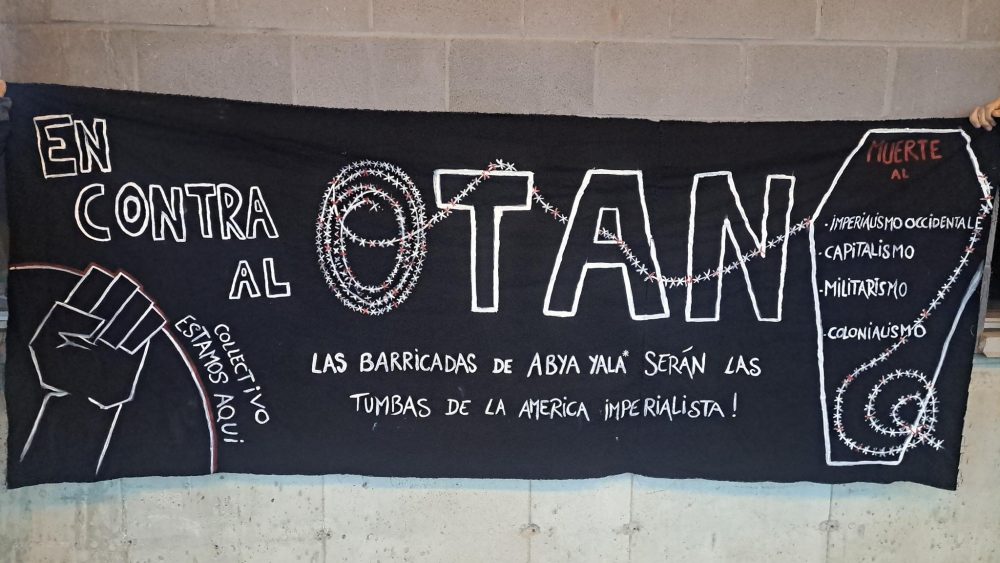
Anonymous submission to MTL Counter-info
If we are writing these lines today, it is because for several days, the media have been endlessly focusing on broken windows and spilled paint following last Friday’s anti-NATO demonstration. This obsession with the destruction of material goods, however, obscures a much more fundamental question: why is anger exploding in this way?
Where the media focuses on inanimate objects, they neglect a much more complex emotional response: this violence is not gratuitous. It symbolizes a cry of helplessness in the face of destroyed human lives, erased memories, and persistent pain that, far from being heard, is reduced to statistics or isolated facts. The debate should not be limited to broken windows, but should ask what motivates this desperate gesture: a distress, a cry of revolt in the face of insidious and omnipresent violence.
We, members of the Colectivo Estamos Aquí, went to this demonstration to express a legitimate anger: that of the survivors of a military dictatorship in Guatemala, which caused more than 250,000 deaths, 45,000 disappearances, and destroyed hundreds of Indigenous communities. This is the memory that we came to defend. A memory that the authorities of the Americas and Europe seem to want to relegate to the background, under the pretext of political and international issues that are too complex for the populace. But what about the integrity of the colonized, displaced, and killed people? Their emotions and traumas, their own issues? This violence, that of the oppressed, seems to have been normalized, even forgotten.
Anticolonial struggles, whether in Latin America or elsewhere, are all linked by common roots: exploitation, domination, and dehumanization. These struggles, despite the diversity of their forms and contexts, all attack a global system of injustice and repression.
However, the media prefer to divert attention from the root causes and focus on the material damage. In doing so, they minimize the violence of a system that destroys human lives in favor of commodities. It is as if, somewhere, the roles have been reversed and that it is now objects—and not human beings—that embody the soul of the world.
In this hierarchy of values, where possessions are elevated to the highest rank, human beings are gradually reduced to simple functions: those of producers, consumers, tools of capitalism. The real violence here is not the breaking of windows, but the systematic disregard for human lives.
Everywhere, Indigenous peoples are reduced to exotic symbols or exploitable resources. Their lands are plundered, their cultures marginalized, and their voices stifled. This dehumanizing treatment reflects a persistent colonial vision, where the dignity of human beings is denied to justify the exploitation of resources.
We are told that violence has no place. Yet, faced with institutional violence of monstrous force and magnitude, the question deserves to be asked: is violence not sometimes the only possible response?